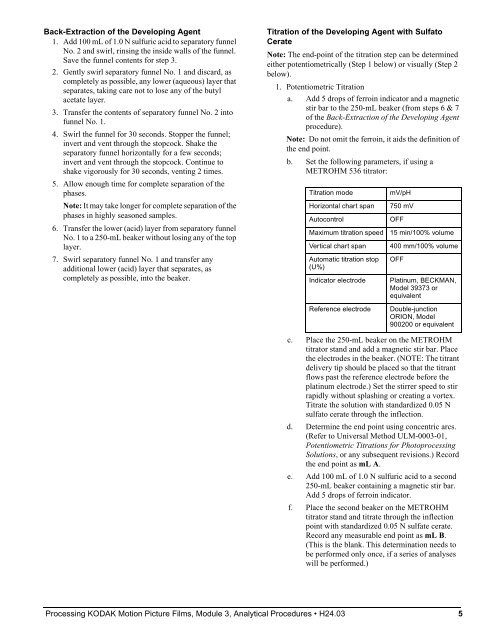Processing kodak motion picture films, module 3 analytical procedures
Processing kodak motion picture films, module 3 analytical procedures
Processing kodak motion picture films, module 3 analytical procedures
Create successful ePaper yourself
Turn your PDF publications into a flip-book with our unique Google optimized e-Paper software.
Back-Extraction of the Developing Agent<br />
1. Add 100 mL of 1.0 N sulfuric acid to separatory funnel<br />
No. 2 and swirl, rinsing the inside walls of the funnel.<br />
Save the funnel contents for step 3.<br />
2. Gently swirl separatory funnel No. 1 and discard, as<br />
completely as possible, any lower (aqueous) layer that<br />
separates, taking care not to lose any of the butyl<br />
acetate layer.<br />
3. Transfer the contents of separatory funnel No. 2 into<br />
funnel No. 1.<br />
4. Swirl the funnel for 30 seconds. Stopper the funnel;<br />
invert and vent through the stopcock. Shake the<br />
separatory funnel horizontally for a few seconds;<br />
invert and vent through the stopcock. Continue to<br />
shake vigorously for 30 seconds, venting 2 times.<br />
5. Allow enough time for complete separation of the<br />
phases.<br />
Note: It may take longer for complete separation of the<br />
phases in highly seasoned samples.<br />
6. Transfer the lower (acid) layer from separatory funnel<br />
No. 1 to a 250-mL beaker without losing any of the top<br />
layer.<br />
7. Swirl separatory funnel No. 1 and transfer any<br />
additional lower (acid) layer that separates, as<br />
completely as possible, into the beaker.<br />
Titration of the Developing Agent with Sulfato<br />
Cerate<br />
Note: The end-point of the titration step can be determined<br />
either potentiometrically (Step 1 below) or visually (Step 2<br />
below).<br />
1. Potentiometric Titration<br />
a. Add 5 drops of ferroin indicator and a magnetic<br />
stir bar to the 250-mL beaker (from steps 6 & 7<br />
of the Back-Extraction of the Developing Agent<br />
procedure).<br />
Note: Do not omit the ferroin, it aids the definition of<br />
the end point.<br />
b. Set the following parameters, if using a<br />
METROHM 536 titrator:<br />
Titration mode mV/pH<br />
Horizontal chart span 750 mV<br />
Autocontrol OFF<br />
Maximum titration speed 15 min/100% volume<br />
Vertical chart span 400 mm/100% volume<br />
Automatic titration stop<br />
(U%)<br />
c. Place the 250-mL beaker on the METROHM<br />
titrator stand and add a magnetic stir bar. Place<br />
the electrodes in the beaker. (NOTE: The titrant<br />
delivery tip should be placed so that the titrant<br />
flows past the reference electrode before the<br />
platinum electrode.) Set the stirrer speed to stir<br />
rapidly without splashing or creating a vortex.<br />
Titrate the solution with standardized 0.05 N<br />
sulfato cerate through the inflection.<br />
d. Determine the end point using concentric arcs.<br />
(Refer to Universal Method ULM-0003-01,<br />
Potentiometric Titrations for Photoprocessing<br />
Solutions, or any subsequent revisions.) Record<br />
the end point as mL A.<br />
e. Add 100 mL of 1.0 N sulfuric acid to a second<br />
250-mL beaker containing a magnetic stir bar.<br />
Add 5 drops of ferroin indicator.<br />
f. Place the second beaker on the METROHM<br />
titrator stand and titrate through the inflection<br />
point with standardized 0.05 N sulfate cerate.<br />
Record any measurable end point as mL B.<br />
(This is the blank. This determination needs to<br />
be performed only once, if a series of analyses<br />
will be performed.)<br />
<strong>Processing</strong> KODAK Motion Picture Films, Module 3, Analytical Procedures H24.03 5<br />
OFF<br />
Indicator electrode Platinum, BECKMAN,<br />
Model 39373 or<br />
equivalent<br />
Reference electrode Double-junction<br />
ORION, Model<br />
900200 or equivalent
















